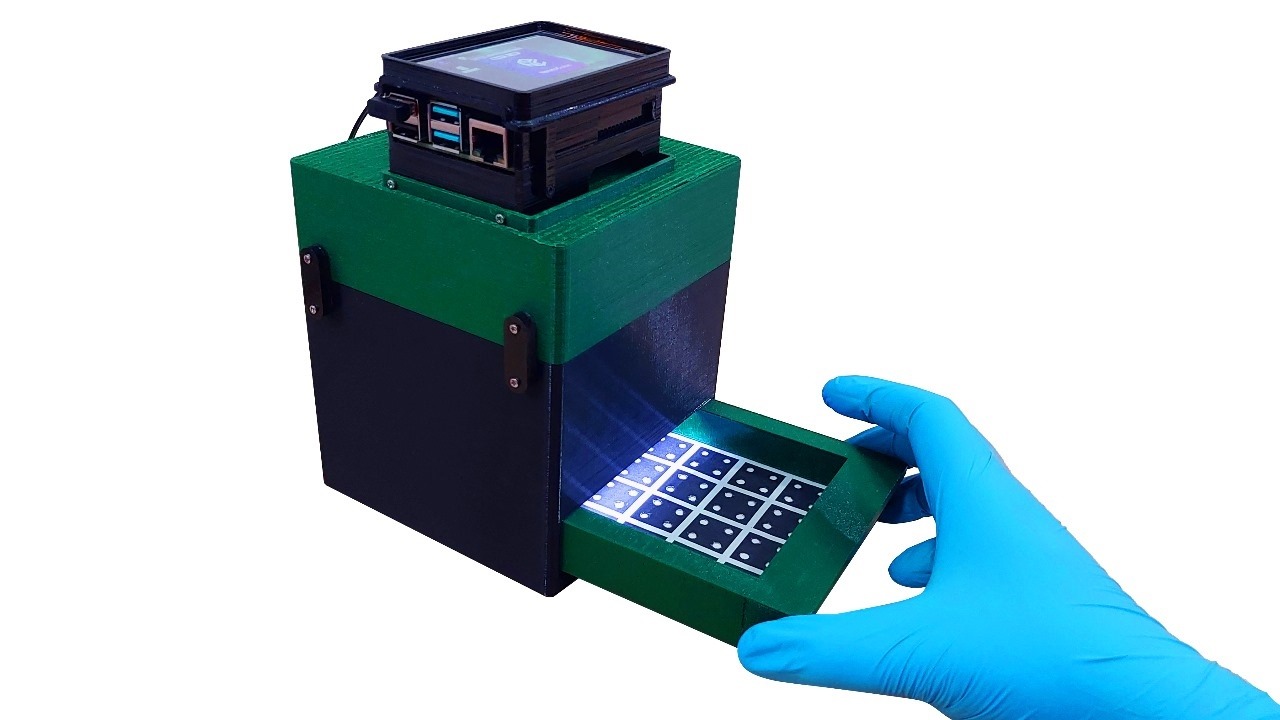ITS Student Team Develops Biosensor Innovation for Detecting Neurological Disorders

Annisa Septyana Ningrum while simulating the NeuroCube tool, a machine learning-based biosensor innovation
ITS Campus, ITS News – A team of students from Institut Teknologi Sepuluh Nopember (ITS) created an innovative Rapid Diagnostic Microfluidic Biosensor detection tool called NeuroCube which is capable of detecting neurological disorders or disorders of the central nervous system and peripheral nervous system. NeuroCube is also supported by increasingly innovative machine learning technology.
Annisa Septyana Ningrum ST, Head of the student team from the ITS Physics Engineering Department Masters study program, said that the idea to develop this biosensor began with awareness of the increasing cases of mental disorders among students. Apart from that, he is also aware of the complexity of diagnosing mental illness and the tendency of patients to give answers that are not appropriate to their condition when seeing a psychologist.
Furthermore, Annisa explained that this biosensor was inspired by the concept of litmus paper which can change color when it reacts with acids or bases. This concept was then applied to neurotransmitter compounds such as dopamine, glutamate, and Nicotinamide Adenosine Dinucleotide Hydrogen (NADH) in urine samples.
From the samples that have been obtained there will be a color change which can provide an indication of the concentration level of compounds that can detect six neurological disorders. These disorders include dementia, obsessive–compulsive disorder (OCD), Attention Deficit Hyperactivity Disorder (ADHD), bipolar disorder, schizophrenia and Alzheimer’s.
In its development, the team consisting of five people was able to combine four important components, namely microfluidic biosensor paper, Raspberry Pi miniprocessor, Liquid Crystal Display (LCD) touch screen, and LED lights into a tool called NeuroCube. This innovation is ultimately claimed to be able to detect neurological disorders in a person using a simple method, namely colorimetry.

Experiments on the NeuroCube tool as a neurological disease detector, the result of innovation by a team of Master’s students from the ITS Engineering Physics Department
Annisa highlighted the function of microfluidic biosensor paper which is capable of being an indicator through color changes when it is dripped with neurotransmitter compounds and reacted with the reagent. The color produced will also have its own level, such as dopamine which will change color from clear to yellow to red according to the concentration of the compound.
Turning to the Rasberry Pi component in the NeuroCube framework, it is a small computer that works as a Central Processing Unit (CPU) which is capable of taking pictures via a connected camera. The resulting image will later go through image processing in a program algorithm to convert the color of the reaction result into compound concentration. This is used as input for machine learning to determine the percentage risk of a person’s neurological disorders.
Not only that, the LED light is able to control the intensity of light entering the camera connected to the NeuroCube itself. What’s more interesting, NeuroCube is also equipped with an LCD touch screen to operate the entire process of compound detection and prediction of neurological disorders in a simple Graphical User Interface (GUI).

NeuroCube prototype, a machine learning-based biosensor innovation created by a team of ITS students
Annisa said that this innovation has added value in the form of the potential to use biosensor and machine learning technology to detect disease risk. “The NeuroCube that we are developing can produce further analysis and enable the development of detection of other diseases besides neurological disorders,” he said.
Annisa and her team hope that NeuroCube can continue to develop until it can become a multiplex detection tool or the ability to detect more than one disease at once. He also hopes that awareness of the potential of this biosensor can increase in Indonesian society, especially among the younger generation.
Due to this brilliant innovation, the team, which was supervised directly by Dr. Rer Nat Ruri Agung Wahyuono, has also succeeded in winning a gold medal in the National Student Scientific Week (Pimnas) presentation category in the Student Creativity Program for Creative Work (PKM-KC). “In the future, we want this innovation to continue to develop in expanding the ability to diagnose more diseases,” concluded Annisa hopefully. (ITS Public Relations)
Reporter: Nabila Rahadatul Aisy Koestriyaningrum
Related News
-
ITS Doctor Initiates World’s First Microexpression-Based Kinship Identification
ITS Campus, ITS News — Institut Teknologi Sepuluh Nopember (ITS) never stops producing outstanding doctoral graduates. Becoming the first
January 25, 2024 20:01 -
ITS Professor Supports Industrial Independence Based on Convection Heat Transfer
ITS Campus, ITS News — PIncreasingly rapid industrial development also demands the availability of energy to run company operations.
January 25, 2024 20:01 -
Supporting Conservation Activities, ITS Launches 1,000 Eco-School Movement Program
ITS Campus, ITS News — In commemoration of National Waste Awareness Day, the Institut Teknologi Sepuluh Nopember (ITS) through
January 25, 2024 20:01 -
ITS Lecturer Highlights Bullion Bank Benefits for Indonesia’s Gold Downstreaming
ITS Campus, ITS News — The launch of Indonesia’s first Bullion Bank or Gold Bank, Wednesday (26/2), marks Indonesia’s commitment
January 25, 2024 20:01
